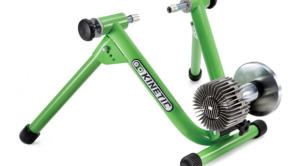The ubiquitous product for indoor cycling was and remains the turbo trainer. It's a device that a cyclist attaches to the rear of his bike, suspending it just above the ground, exerting some form of resistance while you pedal. (Think mouse and wheel.)
Such force can be applied either to the rear tire or the cassette, and this is one way to stick trainers into categories. The method for generating resistance is the other: Wind, Magnetic, Fluid.

Wind, magnetic and fluid trainers, also referred to as wheel-on trainers, attach to a bike via a clamp that locks to the rear wheel QR skewer. The clamp is adjustable so that the rear tire can be aligned in the middle of the roller. The roller, which is attached to a flywheel, is then adjusted via a clutch knob so that it presses against the rear tire. The flywheel attached to the roller provides the resistance in the above photo; one can see how fans create the resistance. A flywheel also works to overcome the resistance, in that it provides inertia that keeps the drum from spinning down. Generally the larger the flywheel the more realistic the ride.
Wind resistant trainers are among the least expensive ($100-and-up) turbo trainers and have the fewest features. The resistance is limited, they are noisier, and have the least realistic feel of the trainers available, the exception the LeMond Revolution trainer. Wind trainers are generally the entry level models.

Magnetic trainers are mid-range trainer. They operate the same way, but the flywheel has metal disc/plate inside the unit than spins and generates drag (magnetic field generating resistance). Some newer models use a current to create an electromagnetic field that can be controlled digitally and therefore more accurately. The ability to exert and measure resistance precisely, and to control and record the session remotely, makes it a Smart Trainer and will be examined separately. Overall, magnetic trainers provide improved resistance and feel over wind trainers with a marginal increase in price ($200 and up) and are a cost effective option.

Fluid trainers may be the most popular type of trainer on the market and for good reason. They operate by a blade spinning though a fluid which in a self-contained unit. Fluid trainers offer a more realistic feel than wind and magnetic trainers, are quieter, and provide sufficient resistance. They do have a reputation for getting hot but most of the newer models have a fan to prevent overheating. Some users also report that these trainers can leak fluid, but this is rare. Prices on Fluid trainers can start at around $350.

Within the fluid trainer category there is one unique model, the Kurt Kinetic Rock and Roll ($549). It sits on a pivot that allows the bike frame to tilt left to right while pedalling to deliver a more realistic experience, and possibly less stress on the frame. It is a nice feature that is really noticeable during brief, hard efforts, or anytime you get out of the saddle.

Direct drive trainers are the rage. They are also the most expensive of all the trainers. Unlike all of the wheel-on models that attach via a QR skewer, direct drive trainers literally take the place of the rear wheel. Direct drive trainers are often quieter, more stable, provide more resistance, and a better feel, and do not wear down a tire. Did I say they are the most expensive? One of the more popular direct drive trainers, the Wahoo Kickr, sells for $1199 and this is not the upper limit.
Still, direct drive trainers are coming down in price. Dumb direct drive trainers using the same sort of resistance options discussed above (wind, mag, fluid) start around $400.

Trainers have become an effective and efficient tool in training because it allows for cycling in a controlled environment. Choosing a trainer requires forethought on how one intends to use the trainer. There are advantages and disadvantages to each type of trainer so recommending the ‘best' trainer will always depend on the user and questions such as: Do you have a power meter? Is noise an issue? Do you intend on training occasionally or often on the trainer? And do you want to take advantage of software such as Zwift or TrainerRoad during your training rides?
If you are interested in how to use leverage various software programs to take advantage of smart trainers, stay tuned for an article dedicated to smart trainers and virtual training.
Need more help? Check out some of the links to similar articles just below this one.



